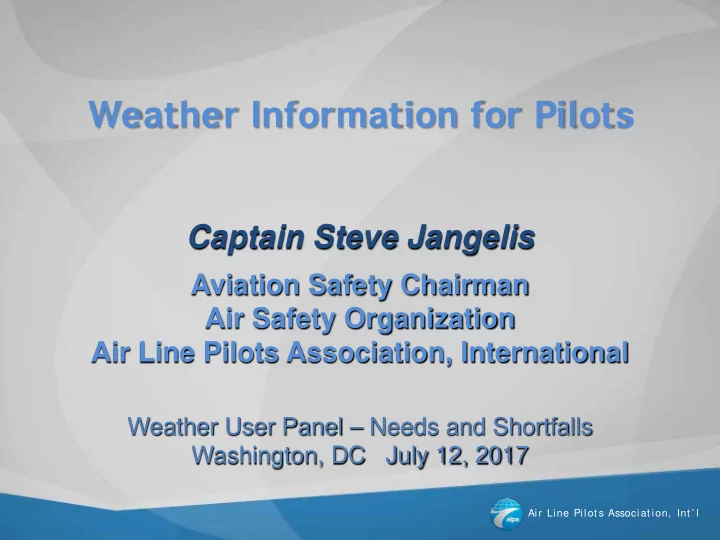

Weather Information for Pilots Captain Steve Jangelis Aviation Safety Chairman Air Safety Organization Air Line Pilots Association, International Weather User Panel – Needs and Shortfalls Washington, DC July 12, 2017 Air Line Pilot s Associat ion, Int ’ l
Agenda S urface Observations When Do Pilots Use Them? What Do Pilots Do with Them? Accuracy and Validity of the Data What Happens if They Are Missing? PIREPs Turbulence Information Air Line Pilot s Associat ion, Int ’ l
When Do Pilots Use Surface Observation? Takeoff and Landing Phase; Weather Packet must include Departure Observations Destination Observations Destination TAF Alternate Airport(s) Observations (if required) Alternate Airport(s) TAF(s) (if required) Any hazard to flight identified by the Dispatcher as relevant to the safe operation of the flight. (Volcanic eruption, Mountain waves, etc) Air Line Pilot s Associat ion, Int ’ l
What do Pilots do with Surface Observations? Compute aircraft performance, often known as Takeoff and Landing Data (TOLD) Determine which runway is in use, if Control Tower closed Determine if airport is equipped for the operation due to weather (Category II or III Approach) Air Line Pilot s Associat ion, Int ’ l
Accurate and Valid Surface Observations Pilots need to trust surface data for the purpose of computing aircraft performance It’ s critical for pilots when receiving surface information that the data is accurate A safe takeoff or landing depend on accurate data Pilots Consider the S ource of the Data Tower, ATIS , Weather Observer, AS OS Air Line Pilot s Associat ion, Int ’ l
Reports Whether VMC or IMC, Pilots will not takeoff or conduct approaches to any airport without a valid report of airport weather conditions. Dispatch IS allowed without a report IF a valid weather report can be obtained prior to commencing the approach. Air Line Pilot s Associat ion, Int ’ l
Validity Reports obtained from ATIS , AWOS / AS OS , FS S , VOLMET, the Dispatcher or any Air Traffic Controller are considered valid. Report must contain the following: Time of the observation Wind direction/ S peed Visibility Ceiling Temperature/ Dew point Altimeter setting Air Line Pilot s Associat ion, Int ’ l
Validity-Missing Items Dew point can be missing if it is not needed for MEL/ Performance requirements. The NWS Real-Time Mesoscale Analysis (RTMA) product may be used for missing temperature and if previously approved by the FAA, used for other missing variables. Air Line Pilot s Associat ion, Int ’ l
Validity-Approved Source US National Weather S ervice Company Meteorology Department A weather facility approved by the NWS / FAA Any other nation’ s weather service Air Line Pilot s Associat ion, Int ’ l
PIREP Information When are PIREPs Needed: During Takeoff and Climb Phase: • Windshear, Turbulence, Icing, Wildlife During Enroute Phase: • Turbulence, Precipitation During Approach and Landing Phase: • Windshear, Turbulence, Icing, Precipitation, Braking Action Reports, and Wildlife Air Line Pilot s Associat ion, Int ’ l
PIREP Information PIREPs need to be precise and accurate Pilots need to be able to trust PIREP data, so it’ s critical for pilots when giving and receiving PIREP information that the data is accurate. For Example: Braking Action Reports • Different airplanes yield different braking abilities • ATC should transmit ALL braking actions less than good, if the runway has not been tended to by the airport • Airports should monitor all PIREPS Air Line Pilot s Associat ion, Int ’ l
Turbulence Information Predicting the where, when and intensity of turbulence is notoriously difficult to do. But Delta has developed a new, industry- leading app that’ s helping pilots better spot and avoid it. Delta’ s Flight Weather Viewer app provides pilots with real-time graphics of turbulence observations and forecasts on the flight deck. Air Line Pilot s Associat ion, Int ’ l
Tool in the Cockpit for Operational Decisions Boxes represent aircraft reports color coded for ride conditions Air Line Pilot s Associat ion, Int ’ l
Reports Validate Forecast and Facilitate Operational Decisions This is the actual turbulence level Touching “View Report” when a report box is opened displays the Turbulence Report history of the aircraft. Air Line Pilot s Associat ion, Int ’ l
Summary S urface Observations are critical to pilots with specific meteorological information to help compute aircraft performance for takeoff and landing S urface data needs to be precise, accurate and current from a reliable approved source PIREP data helps pilots with detailed information for each phase of flight Turbulence information helps find smooth air and reduce passenger/ FA inj uries. Air Line Pilot s Associat ion, Int ’ l
Together we are making a difference THANK YOU Steve.Jangelis@alpa.org Air Line Pilot s Associat ion, Int ’ l 16
Recommend
More recommend